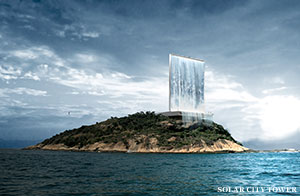
Brazil is known for attractive women, Carnival, the Amazon, Samba and even a popular waxing procedure. But will a giant waterfall soon be added to the list?
In an effort to make Rio's Olympics in 2016 the first ever zero-carbon games, the city's proposed Solar City Tower will include solar panels. The building is designed to create renewable energy for use in the Olympic Village as well as the city of Rio. A large solar power plant generates energy during the day, and any excess power is used to pump seawater into a storage tank within the tower. At night, the water will be released and provide nighttime power for the city.
And during the Olympic games, water will be pumped out to create a massive, sky-high, artificial waterfall over the edges of the building.
On the ocean side of the tower (behind the waterfall) will be a cafeteria and shop. Visitors can even go up to the top floor, where an observation deck will offer 360-degree views of the ocean and city. And -- you knew this was coming -- a bungee platform will be available for adventurous visitors.
But just how “sustainable” and “green” is this structure, really? The building architects say the waterfall is meant to be "a symbol for the forces of nature." But isn’t that what the "Waterfalls" art installation in New York City was supposed to be? That display sprayed salt water into the air that killed some of the surrounding greenery.
So while the hope is to create an icon for Rio's Olympics that's as forward-thinking as the country itself, if there is one thing we already know about waterfalls, it’s don’t go chasing them.
-- Follow Erica Orange on Twitter at @ErOrange




